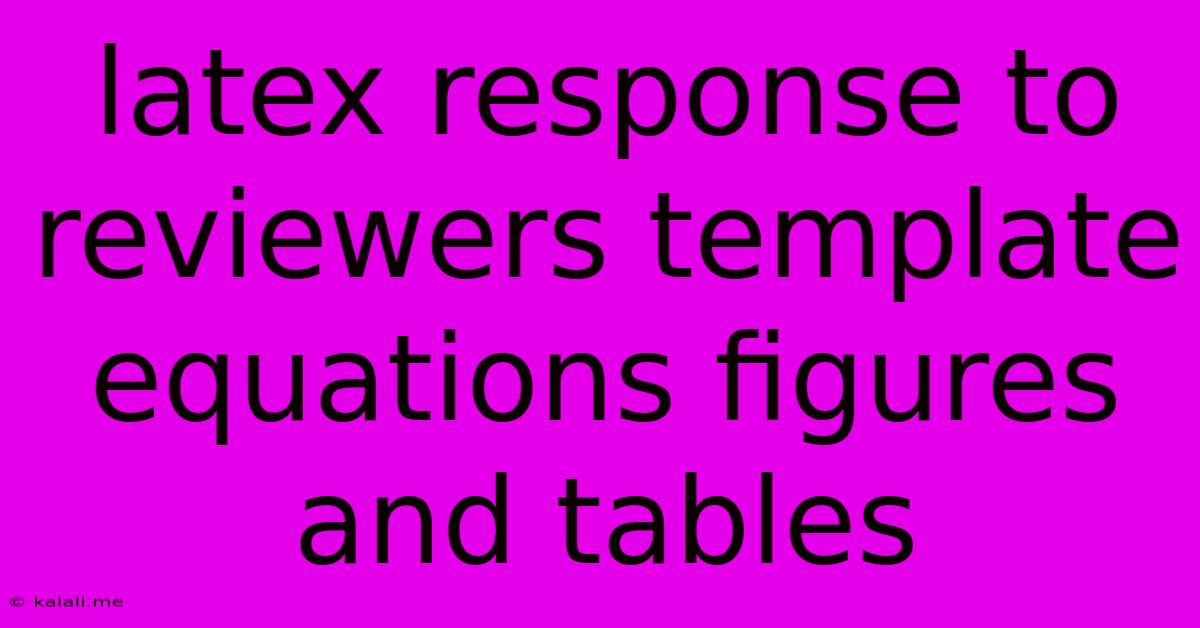Latex Response To Reviewers Template Equations Figures And Tables
Kalali
May 24, 2025 · 3 min read

Table of Contents
Responding to Reviewer Comments on Your LaTeX Manuscript: A Comprehensive Guide to Equations, Figures, and Tables
Submitting a manuscript is a significant step in the research process, and receiving reviewer comments can feel daunting. However, a well-structured and professional response is crucial for acceptance. This guide focuses on effectively addressing comments related to equations, figures, and tables within your LaTeX document. We'll explore best practices for revising your manuscript and crafting a clear and concise response letter.
This article will equip you with the tools to efficiently manage reviewer feedback, particularly concerning the mathematical and visual components of your paper. Learning to expertly handle these elements will significantly improve your chances of publication.
Understanding Reviewer Comments
Before diving into revisions, thoroughly analyze each comment. Categorize them by type (e.g., major revisions, minor edits, suggestions) to prioritize your workflow. When addressing comments related to equations, figures, and tables, be specific and provide clear explanations for all changes made.
Addressing Comments on Equations
Reviewers often comment on the clarity, accuracy, or completeness of your mathematical derivations. When responding to these concerns:
- Precisely identify the equation: Refer to the equation number (e.g., "Equation 3 has been revised as follows...") to ensure clarity.
- Explain changes made: Clearly state the modifications you made to address the reviewer's concerns. If you added explanations, mention their location within the revised text. For example, "We have added a detailed explanation of the derivation of Equation 5 in Section 3.2."
- Justify your approach: If you disagree with a suggestion, respectfully explain your reasoning. Provide strong evidence or citations to support your approach.
Example in Response Letter:
"Reviewer 2 raised concerns about the clarity of Equation 7. We have revised this equation and added a detailed explanation in Section 4.1, clarifying the assumptions made in the derivation."
Example in LaTeX Code (Illustrative):
%Before:
\begin{equation}
y = mx + c
\end{equation}
%After:
\begin{equation}
y = mx + c \label{eq:1}
\end{equation}
\textit{where m represents the slope and c represents the y-intercept. This linear equation models... (added explanation)}
Addressing Comments on Figures
Figures are critical for visual communication in scientific writing. Reviewers often suggest improvements in clarity, labeling, or data representation.
- Refer to figure numbers: Clearly specify the figure in question (e.g., "Figure 3 has been updated as follows...").
- Describe modifications: Detail all changes made: improved labeling, revised legends, added annotations, or even complete figure redrawing. If you used specialized software, mention it.
- Provide justifications: If you didn't implement a suggestion, explain your rationale clearly.
Example in Response Letter:
"Reviewer 1 suggested adding error bars to Figure 2. We have incorporated these error bars, calculated using standard deviation, as shown in the revised figure."
Addressing Comments on Tables
Similar to figures, tables require careful consideration. Reviewers might critique the layout, formatting, or data presentation.
- Use table numbers: Reference the table (e.g., "Table 1 has been revised to address the reviewer's comments").
- Specify changes: Detail all formatting or content changes. This could include adding column headers, changing units, or re-organizing data.
- Explain the rationale: Clearly justify your decisions, particularly if you disagreed with any suggested changes.
Example in Response Letter:
"The formatting of Table 3 has been revised to improve readability. We have added a column specifying units for clarity, as suggested by Reviewer 3."
Structuring Your Response Letter
Organize your response letter logically. Follow the reviewers' comments point-by-point. Use a numbered or bulleted list to maintain clarity. Each item should clearly address the specific comment and demonstrate the changes you made. Always remain professional and respectful, even when disagreeing with a suggestion.
By following these guidelines, you can efficiently address reviewer comments related to equations, figures, and tables in your LaTeX manuscript, increasing your chances of publication. Remember that clear communication and a thorough response are key elements in the revision process.
Latest Posts
Latest Posts
-
How Are Waves And Electricity Difference
May 25, 2025
-
Why Did Jesus Write In The Sand Twice
May 25, 2025
-
Check Number Of Cores On Linux
May 25, 2025
-
How To Make A Mouse Quieter
May 25, 2025
-
How Much Is A Bunch Of Scallions
May 25, 2025
Related Post
Thank you for visiting our website which covers about Latex Response To Reviewers Template Equations Figures And Tables . We hope the information provided has been useful to you. Feel free to contact us if you have any questions or need further assistance. See you next time and don't miss to bookmark.